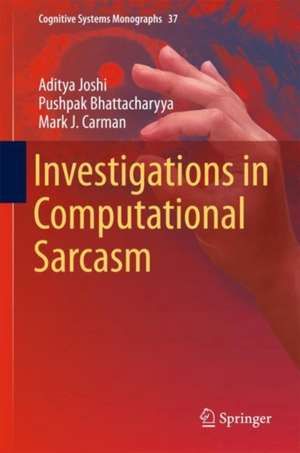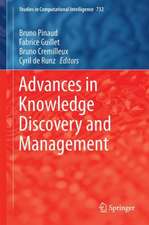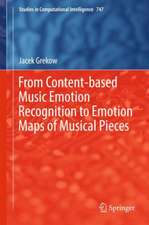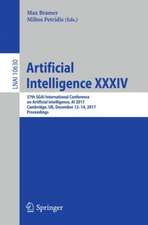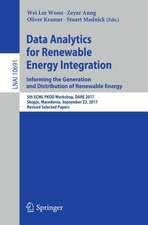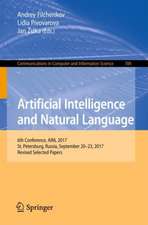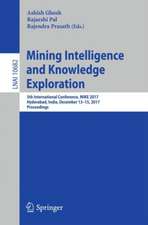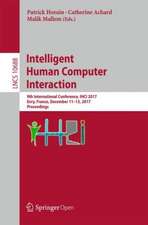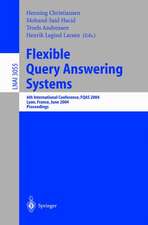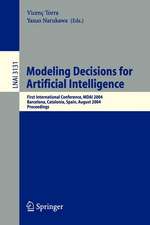Investigations in Computational Sarcasm: Cognitive Systems Monographs, cartea 37
Autor Aditya Joshi, Pushpak Bhattacharyya, Mark J. Carmanen Limba Engleză Hardback – 3 apr 2018
| Toate formatele și edițiile | Preț | Express |
|---|---|---|
| Paperback (1) | 638.55 lei 3-5 săpt. | |
| Springer Nature Singapore – 19 ian 2019 | 638.55 lei 3-5 săpt. | |
| Hardback (1) | 645.31 lei 3-5 săpt. | |
| Springer Nature Singapore – 3 apr 2018 | 645.31 lei 3-5 săpt. |
Din seria Cognitive Systems Monographs
- 15%
 Preț: 647.59 lei
Preț: 647.59 lei - 18%
 Preț: 957.62 lei
Preț: 957.62 lei - 15%
 Preț: 632.55 lei
Preț: 632.55 lei - 15%
 Preț: 643.99 lei
Preț: 643.99 lei - 20%
 Preț: 1447.17 lei
Preț: 1447.17 lei - 15%
 Preț: 629.73 lei
Preț: 629.73 lei - 15%
 Preț: 633.02 lei
Preț: 633.02 lei - 15%
 Preț: 639.90 lei
Preț: 639.90 lei - 20%
 Preț: 643.50 lei
Preț: 643.50 lei - 15%
 Preț: 640.55 lei
Preț: 640.55 lei - 15%
 Preț: 641.71 lei
Preț: 641.71 lei - 5%
 Preț: 1103.75 lei
Preț: 1103.75 lei - 15%
 Preț: 637.59 lei
Preț: 637.59 lei - 15%
 Preț: 648.24 lei
Preț: 648.24 lei - 20%
 Preț: 650.40 lei
Preț: 650.40 lei -
 Preț: 391.02 lei
Preț: 391.02 lei - 15%
 Preț: 643.48 lei
Preț: 643.48 lei - 20%
 Preț: 663.61 lei
Preț: 663.61 lei - 20%
 Preț: 652.54 lei
Preț: 652.54 lei - 20%
 Preț: 699.43 lei
Preț: 699.43 lei - 15%
 Preț: 640.88 lei
Preț: 640.88 lei - 20%
 Preț: 657.67 lei
Preț: 657.67 lei - 20%
 Preț: 1000.04 lei
Preț: 1000.04 lei - 20%
 Preț: 648.44 lei
Preț: 648.44 lei - 18%
 Preț: 886.92 lei
Preț: 886.92 lei - 20%
 Preț: 647.61 lei
Preț: 647.61 lei - 20%
 Preț: 651.09 lei
Preț: 651.09 lei - 20%
 Preț: 1161.71 lei
Preț: 1161.71 lei - 15%
 Preț: 642.68 lei
Preț: 642.68 lei - 20%
 Preț: 649.93 lei
Preț: 649.93 lei - 18%
 Preț: 944.19 lei
Preț: 944.19 lei
Preț: 645.31 lei
Preț vechi: 806.64 lei
-20% Nou
Puncte Express: 968
Preț estimativ în valută:
123.49€ • 134.10$ • 103.74£
123.49€ • 134.10$ • 103.74£
Carte disponibilă
Livrare economică 01-15 aprilie
Preluare comenzi: 021 569.72.76
Specificații
ISBN-13: 9789811083952
ISBN-10: 9811083959
Pagini: 145
Ilustrații: XII, 143 p. 12 illus., 4 illus. in color.
Dimensiuni: 155 x 235 mm
Greutate: 0.41 kg
Ediția:1st ed. 2018
Editura: Springer Nature Singapore
Colecția Springer
Seria Cognitive Systems Monographs
Locul publicării:Singapore, Singapore
ISBN-10: 9811083959
Pagini: 145
Ilustrații: XII, 143 p. 12 illus., 4 illus. in color.
Dimensiuni: 155 x 235 mm
Greutate: 0.41 kg
Ediția:1st ed. 2018
Editura: Springer Nature Singapore
Colecția Springer
Seria Cognitive Systems Monographs
Locul publicării:Singapore, Singapore
Cuprins
1. Introduction.- 2. Literature Survey.- 3. Understanding the Phenomenon of Sarcasm.- 4. Sarcasm Detection using Incongruity within Target Text.- 5. Sarcasm Detection using Contextual Incongruity.- 6. Sarcasm Generation.- 7. Conclusion & Future Work.
Notă biografică
Aditya Joshi has been a PhD student at IITB-Monash Research Academy, Mumbai, a joint PhD programme run by the Indian Institute of Technology Bombay (IIT Bombay) and Monash University, Australia, since January 2013. His primary research focus is computational sarcasm, and he has explored different ways in which incongruity can be captured in order to detect and generate sarcasm. In addition, he has worked on innovative applications of natural language processing (NLP) such as sentiment analysis for Indian languages, drunk-texting prediction, news headline translation, and political issue extraction. The monograph is an outcome of Aditya’s PhD research.
Dr. Pushpak Bhattacharyya is the current president of The Association for Computational Linguistics (ACL) (2016–17). He is the Director of the Indian Institute of Technology Patna (IIT Patna) and Vijay and Sita Vashee Chair Professor at the Department of Computer Science and Engineering, Indian Institute of Technology Bombay (IIT Bombay). He was educated at the Indian Institute of Technology Kharagpur (IIT Kharagpur) (B.Tech), Indian Institute of Technology Kanpur (IIT Kanpur) (M.Tech.) and IIT Bombay (PhD).
He has been a visiting scholar and faculty member at the Massachusetts Institute of Technology (MIT), Stanford, UT Houston and University Joseph Fouriere (France). Prof. Bhattacharyya’s research areas include natural language processing, machine learning and artificial intelligence (AI). Loved by his students for his inspiring teaching and mentorship, he has guided more than 250 students (PhD, Masters and Bachelors). He has published over 250 research papers, is author of the textbook ‘Machine Translation’ and has led government and industry projects of international and national importance. His significant contributions in the field include multilingual lexical knowledge bases and projection. Prof. Bhattacharyya is a fellow of the National Academy of Engineering and recipient of the IIT Bombay Patwardhan Award and the Indian Institute of Technology Roorkee (IIT Roorkee) VNMM award,both for technology development. He has also received IBM, Microsoft, Yahoo and United Nations faculty grants.
Dr. Mark J. Carman is a senior lecturer at the Faculty of Information Technology, Monash University, Australia. He obtained a Ph.D. from the University of Trento, Italy in 2004. His research and interests span theoretical studies (e.g. investigating statistical properties of information retrieval measures), to practical applications (e.g. technology for assisting police during digital forensic investigations). Dr. Carman has authored a large number of publications in prestigious venues, including full papers at SIGIR, KDD, IJCAI, CIKM, WSDM, CoNLL, and ECIR, and articles in TOIS, IR, JMLR, ML, PR, JAIR and IP&M.
Dr. Pushpak Bhattacharyya is the current president of The Association for Computational Linguistics (ACL) (2016–17). He is the Director of the Indian Institute of Technology Patna (IIT Patna) and Vijay and Sita Vashee Chair Professor at the Department of Computer Science and Engineering, Indian Institute of Technology Bombay (IIT Bombay). He was educated at the Indian Institute of Technology Kharagpur (IIT Kharagpur) (B.Tech), Indian Institute of Technology Kanpur (IIT Kanpur) (M.Tech.) and IIT Bombay (PhD).
He has been a visiting scholar and faculty member at the Massachusetts Institute of Technology (MIT), Stanford, UT Houston and University Joseph Fouriere (France). Prof. Bhattacharyya’s research areas include natural language processing, machine learning and artificial intelligence (AI). Loved by his students for his inspiring teaching and mentorship, he has guided more than 250 students (PhD, Masters and Bachelors). He has published over 250 research papers, is author of the textbook ‘Machine Translation’ and has led government and industry projects of international and national importance. His significant contributions in the field include multilingual lexical knowledge bases and projection. Prof. Bhattacharyya is a fellow of the National Academy of Engineering and recipient of the IIT Bombay Patwardhan Award and the Indian Institute of Technology Roorkee (IIT Roorkee) VNMM award,both for technology development. He has also received IBM, Microsoft, Yahoo and United Nations faculty grants.
Dr. Mark J. Carman is a senior lecturer at the Faculty of Information Technology, Monash University, Australia. He obtained a Ph.D. from the University of Trento, Italy in 2004. His research and interests span theoretical studies (e.g. investigating statistical properties of information retrieval measures), to practical applications (e.g. technology for assisting police during digital forensic investigations). Dr. Carman has authored a large number of publications in prestigious venues, including full papers at SIGIR, KDD, IJCAI, CIKM, WSDM, CoNLL, and ECIR, and articles in TOIS, IR, JMLR, ML, PR, JAIR and IP&M.
Textul de pe ultima copertă
This book describes the authors’ investigations of computational sarcasm based on the notion of incongruity. In addition, it provides a holistic view of past work in computational sarcasm and the challenges and opportunities that lie ahead. Sarcastic text is a peculiar form of sentiment expression and computational sarcasm refers to computational techniques that process sarcastic text. To first understand the phenomenon of sarcasm, three studies are conducted: (a) how is sarcasm annotation impacted when done by non-native annotators? (b) How is sarcasm annotation impacted when the task is to distinguish between sarcasm and irony? And (c) can targets of sarcasm be identified by humans and computers. Following these studies, the book proposes approaches for two research problems: sarcasm detection and sarcasm generation. To detect sarcasm, incongruity is captured in two ways: ‘intra-textual incongruity’ where the authors look at incongruity within the text to be classified (i.e., target text) and ‘context incongruity’ where the authors incorporate information outside the target text. These approaches use machine-learning techniques such as classifiers, topic models, sequence labelling, and word embeddings. These approaches operate at multiple levels: (a) sentiment incongruity (based on sentiment mixtures), (b) semantic incongruity (based on word embedding distance), (c) language model incongruity (based on unexpected language model), (d) author’s historical context (based on past text by the author), and (e) conversational context (based on cues from the conversation). In the second part of the book, the authors present the first known technique for sarcasm generation, which uses a template-based approach to generate a sarcastic response to user input. This book will prove to be a valuable resource for researchers working on sentiment analysis, especially as applied to automation in social media.
Caracteristici
Provides a tabular summary of the past work on computational sarcasm Lays down the linguistic foundations for computational sarcasm Presents elaborate examples motivating each work module Describes approaches spanning multiple machine learning (ML) and techniques such as classifiers, topic models, and deep-learning-based architectures, etc
